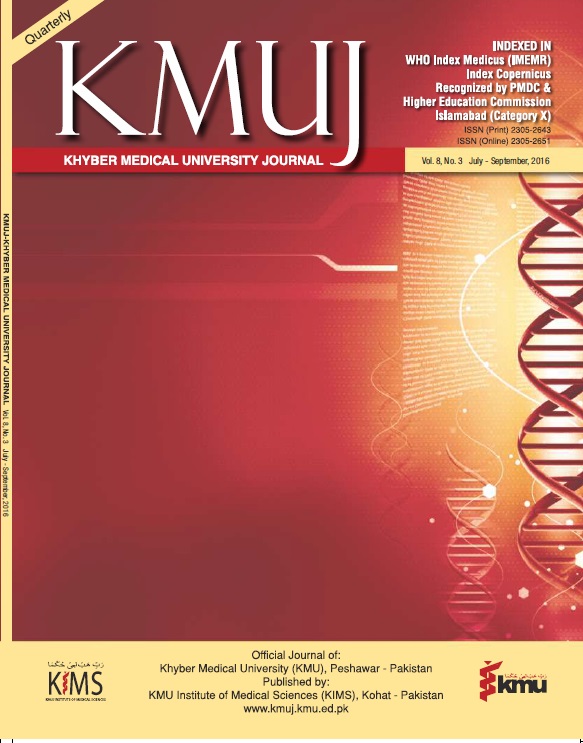FACTORS ASSOCIATED WITH UNDER UTILIZATION OF ANTICOAGULATION IN PATIENTS WITH ATRIAL FIBRILLATION WITH HIGH RISK PROFILE FOR THROMBOEMBOLISM
Main Article Content
Abstract
ABSTRACT
OBJECTIVE: To determine the factors associated with under utilization
of anticoagulation in patients with atrial fibrillation (AF) with high risk
profile for thromboembolism.
METHODS: This descriptive cross-sectional study was conducted at
Cardiovascular Department Lady Reading Hospital Peshawar, Pakistan
and Cardiology Department Hayatabad Medical Complex Peshawar,
Pakistan from 01-12-2014 to 28-02-2015. All patients visiting OPD of
respective hospitals with electrocardiogram (ECG) evidence of AF and
CHADS VASC score 2 or more and mitral stenosis and AF were included.
RESULTS: Out of 205 patients, 114 (55.6%) were males and mean age
was 60.7±4.7 years. Out of 205, 149 (72.7%) were candidates for anticoagulation. AF patients with CHA2DS2 VASc score of ≥2 were 130
while patients with mitral stenosis and AF were 19. Only 41(27.5%)
patients were adequately treated with anticoagulant therapy using
vitamin K antagonist (VKA) or novel oral anticoagulant drugs. Factors
associated with underutilization of anticoagulant therapy were, patient
preference 27.8%, older age of 65 and above 17.6%, use of dual antiplatelet therapy 28.7 %, monitoring issue 9.3%, affordability 8.3% and prior complications due to anticoagulation therapy in 8.3%.
CONCLUSION: Patients refusal of taking anticoagulation therapy,
poverty, older age, lack of monitoring facility, previous complications
or use of anti-platelet therapy are major causes of under utilization of
anticoagulant therapy in patients with AF.
KEY WORDS: Atrial Fibrillation (MeSH), CHADS VASC score 2 (NonMeSH), Dual Antiplatelet Therapy (DAPT) (Non-MeSH), Warfarin
(MeSH) .
Article Details
Work published in KMUJ is licensed under a
Creative Commons Attribution 4.0 License
Authors are permitted and encouraged to post their work online (e.g., in institutional repositories or on their website) prior to and during the submission process, as it can lead to productive exchanges, as well as earlier and greater citation of published work.
(e.g., in institutional repositories or on their website) prior to and during the submission process, as it can lead to productive exchanges, as well as earlier and greater citation of published work.
References
REFERENCES
Wolf PA, Abbott RD, Kannel WB. Atrial fibrillation as an independent risk factor for stroke: the Framingham Study. Stroke 1991;22:983–8.
Sabir I, Khavandi K, Brownrigg J, Camm AJ .Oral anticoagulants for Asian patients with atrial fibrillation.Nat Rev Cardiol. 2014;11(5):290-303
Camm AJ, Lip GY, De Caterina R, et al. ESC Committee for Practice Guidelines (CPG). 2012 focused update of the ESC Guidelines for the management of atrial fibrillation: an update of the 2010 ESC Guidelines for the management of atrial fibrillation. Eur Heart J 2012; 33: 2719–2747.
You JJ, Singer DE, Howard PA, et al. American College of Chest Physicians. Antithrombotic therapy for atrial fibrillation: Antithrombotic Therapy and Prevention of Thrombosis, 9th ed: American College of Chest Physicians Evidence-Based Clinical Practice Guidelines. Chest 2012; 141: e531S–575S
Cowan C, Healicon R, Robson I, et al. The use of anticoagulants in the management of atrial fibrillation among general practices in England. Heart 2013; 99: 1166–1172.
Kakkar AK, Mueller I, Bassand JP, et al. GARFIELD Registry Investigators. Risk profiles and antithrombotic treatment of patients newly diagnosed with atrial fibrillation at risk of stroke: perspectives from the international, observational, prospective GARFIELD registry. PLoS One 2013; 8: e63479.
Nieuwlaat R, Capucci A, Lip GY, et al. Euro Heart Survey Investigators. Antithrombotic treatment in real-life atrial fibrillation patients: a report from the Euro Heart Survey on Atrial Fibrillation. Eur Heart J 2006; 27: 3018–3026.
Scowcroft AC, Lee S, Mant J. Thromboprophylaxis of elderly patients with AF in the UK: an analysis using the General Practice Research Database (GPRD) 2000–2009. Heart 2013; 99: 127–132.
Ogilvie IM, Newton N, Welner SA, et al. Underuse of oral anticoagulants in atrial fibrillation: a systematic review. Am J Med 2010; 123: 638–645.
Lip GY. The role of aspirin for stroke prevention in atrial fibrillation. Nat Rev Cardiol 2011; 8: 602–606.
Mant J, Hobbs FD, Fletcher K, et al. BAFTA investigators; Midland Research Practices Network (MidReC). Warfarin versus aspirin for stroke prevention in an elderly community population with atrial fibrillation (the Birmingham Atrial Fibrillation Treatment of the Aged Study, BAFTA): a randomised controlled trial. Lancet 2007; 370: 493–503.
Lip GY, Nieuwlaat R, Pisters R, et al. Refining clinical risk stratification for predicting stroke and thromboembolism in atrial fibrillation using a novel risk factor-based approach: the euro heart survey on atrial fibrillation. Chest 2010; 137: 263–272.
Tanislav C, Milde S, Schwartzkopff S, Sieweke N, Krämer HH, Juenemann M, Misselwitz B, Kaps .Secondary stroke prevention in atrial fibrillation: a challenge in the clinical practice. BMC Neurology 2014:14:195
Tulner LR, Van Campen JP, Kuper IM, Gijsen GJ, Koks CH, Mac Gillavry MR, van Tinteren H, Beijnen JH, Brandjes DP. Reasons for undertreatment with oral anticoagulants in frail geriatric outpatients with atrial fibrillation: a prospective, descriptive study Drugs Aging.2010;27(1):39-50.
O'Brien EC, Holmes DN, Ansell JE, Allen LA, Hylek E, Kowey PR, Gersh BJ, Fonarow GC, Koller CR, Ezekowitz MD, Mahaffey KW, Chang P, Peterson ED, Piccini JP, Singer DE. Physician practices regarding contraindications to oral anticoagulation in atrial fibrillation: findings from the Outcomes Registry for Better Informed Treatment of Atrial Fibrillation (ORBIT-AF) registry. Am Heart J. 2014 ;167(4):601-609
